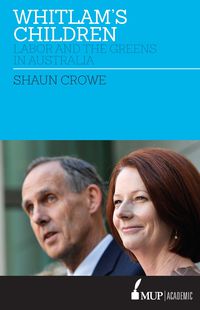‘Whitlam’s Children is lively, well-written and well-researched’, Honest History, 20 February 2019
Shaun Crowe’s Whitlam’s Children: Labor and the Greens in Australia is reviewed by John Warhurst
When Gough Whitlam died in October 2014 his memory was claimed not just by Labor, as one would have predicted, but also by the Greens. Not surprisingly, this outraged Labor people, who saw Whitlam as ‘their man’, and controversy ensued. This cameo forms a very clever hook on which to hang Shaun Crowe’s exploration of the relationship between the two parties.
 Prior to this introduction comes a very thoughtful and complimentary foreword by former Labor Premier of Western Australia, Geoff Gallop, which suggests that a discussion of preference politics would have added to the value of the book without changing its conclusions. Gallop’s useful comments raise broader issues, including the general difficulties of multi-party politics in Australia, compared with a previous era when Australia was characterised as one of the world’s foremost examples of narrow two-party politics.
Prior to this introduction comes a very thoughtful and complimentary foreword by former Labor Premier of Western Australia, Geoff Gallop, which suggests that a discussion of preference politics would have added to the value of the book without changing its conclusions. Gallop’s useful comments raise broader issues, including the general difficulties of multi-party politics in Australia, compared with a previous era when Australia was characterised as one of the world’s foremost examples of narrow two-party politics.
At the heart of our multi-party politics are four parties: Labor, Liberal, Nationals and Greens. On the centre-right side the Liberals and National parties have long formed a coalition when in power – it is even known colloquially as ‘the Coalition’ – while, on the centre-left side, not only are Labor and the Greens not in coalition, but often behave as though they are mortal enemies.
Whether or not Labor and the Greens should form a progressive bloc or coalition is the question at the heart of this lively, well-written and well-researched book. It is an easy and informative read and I highly recommend it.
To address his big question, Crowe begins with a tight and coherent summary of the evolution of the Australian party system. This solid chapter demonstrates that there are always dangers for a major party in collaboration or coalition.
Crowe follows up with an exposition of what he calls ‘two Leftist traditions’. This chapter is full of good summaries of a wide range of Labor scholarship (so much has been written on this topic that it is almost the main focus of mainstream Australian political science) and it shows how much less has been written about the Greens. The imbalance is not unreasonable, however, given the respective sizes and lineages of the two parties.
The remainder of the book comes at the topic from different directions, first reporting on a range of interviews with leading figures in both parties, a majority of whom reject the idea of a progressive coalition. Their thinking and how they reach this conclusion is interesting.
Then follows an examination of such collaboration in the turbulent setting of the minority Gillard government. Crowe sees this period as a positive example of what is possible.
Finally, a large chunk of the book looks at three big policy issues: climate change, refugees and asylum seekers, and taxation and mining. Each of these policy areas – which could have also included industrial relations-employment and where trade unions would fit into a Labor-Green coalition – raises examples of differences and tensions between the Greens and Labor. These tensions, though real, are not the end of the matter, however, as the conservative coalition has itself survived major differences and tensions over the years.
Crowe’s conclusion sums up and draws out the ‘Red-Green’ dilemma. He does this well, highlighting the depth of Labor antipathy to Green inroads into traditional Labor electorates in the inner cities.
Writing from the A.C.T. perspective, I’m personally in favour of a centre-left coalition – as I suspect Crowe is – because it would even up the contest for political office, but I can see the problems. I would have added two extra elements to the author’s really interesting discussion. One would be a more explicit comparison with the Liberal-National Coalition, which has always been a ‘business partnership’ and rarely trouble free. The other would be a discussion of the divisiveness, disdain and anger which surrounds the Greens and which often fails to give any respect to a party which regularly commands the vote of one-tenth of the Australian electorate. If this electorally dangerous edge ever comes off the Greens’ public profile a progressive coalition would become much more likely.
Whitlam’s famous warning to the Victorian Branch of the Labor Party 50 years ago that ‘Certainly, the impotent are pure’ is the heading of Crowe’s conclusion. As a defence of the enduring importance of the attainment of executive political power it can be read mainly as support for modern Labor and a criticism of the modern-day Greens. But it is better read as a more general meditation on the tension between holding to principles and seeking office, a tension which all aspiring politicians should think about as the next federal election comes closer.
* John Warhurst is an Emeritus Professor of Political Science at the Australian National University. He has reviewed This Time: Australia’s Republican Past and Future, by Benjamin T. Jones.


Leave a Reply
You must be logged in to post a comment.